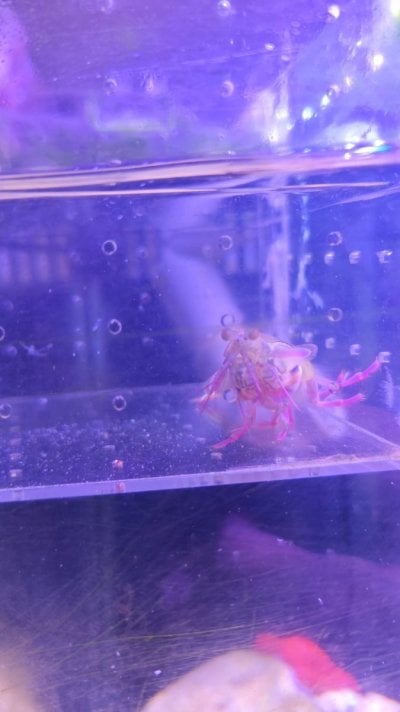Hi, good morning everyone.
Recently my supplier has procured a few different varieties of mantis shrimp in his stock. I definitely want to bring a couple home, but I want to verify their species and make sure the parameters at home are perfect before I do.
First mantis shrimp:

The seller ID’d it as a G. Ternatensis which I’m confident it is. It looks to be a female.
Second mantis shrimp:

This one was ID’d by the seller as an O. Latirosis but I’m not too sure as it doesn’t really match the description on Dr. Caldwell’s guide site. I’d like a second opinion if possible.
Third Mantis:

This one I am confident is a peacock, O. Scyllarus male.
Additionally,
I currently have 3 vacant tanks; They are fully cycled with the salinity ranging from 28-30 PSU.
Tank 1:
Dimensions = 80cm*50cm*45cm
Salinity = 30 PSU
Gallons = 45 US
Tank 2:
Dimensions = 80cm*40cm*40cm
Salinity = 30 PSU
Gallons = 33 US
Tank 3:
Dimensions = 60cm*60cm*60cm
Salinity = 28 PSU
Gallons = 33 US
Each one is equipped with a back filter, a skimmer, wave maker, and has been running for more than a year with consistently stable conditions. Are the species available at the seller compatible with these tanks?
Recently my supplier has procured a few different varieties of mantis shrimp in his stock. I definitely want to bring a couple home, but I want to verify their species and make sure the parameters at home are perfect before I do.
First mantis shrimp:
The seller ID’d it as a G. Ternatensis which I’m confident it is. It looks to be a female.
Second mantis shrimp:
This one was ID’d by the seller as an O. Latirosis but I’m not too sure as it doesn’t really match the description on Dr. Caldwell’s guide site. I’d like a second opinion if possible.
Third Mantis:
This one I am confident is a peacock, O. Scyllarus male.
Additionally,
I currently have 3 vacant tanks; They are fully cycled with the salinity ranging from 28-30 PSU.
Tank 1:
Dimensions = 80cm*50cm*45cm
Salinity = 30 PSU
Gallons = 45 US
Tank 2:
Dimensions = 80cm*40cm*40cm
Salinity = 30 PSU
Gallons = 33 US
Tank 3:
Dimensions = 60cm*60cm*60cm
Salinity = 28 PSU
Gallons = 33 US
Each one is equipped with a back filter, a skimmer, wave maker, and has been running for more than a year with consistently stable conditions. Are the species available at the seller compatible with these tanks?























